“the other dreams of trees”: Journey to Dinka Marie, On Trees and Stories, #TreesTruthTrust
The other day, I found myself on the train from Zellendorf to Tegel Berlin to see Marie, or Dinka Marie, as she’s known - the oldest tree in Berlin. Some say she’s 800 years old, others 900. Goethe loved her, sitting under her shade, writing poems, perhaps meeting Mephistopheles, dreaming of our divided selves. A friend of the devil is a friend of mine. You never know. The mind wanders. So do our feet. Yet, what happens when we get there? How do we get there? I wasn’t sure. Three trains from Zellendorf, one bus, and a two-kilometer walk across Berlin, my journey took me. Two hours to make my way, one kilometer I walked the wrong way from the bus stop. In need of a break, an old German beer offers some respite. I stop and take in the scene, a few elders nursing a pint, the last refuge before entering the woods.
Into the dark forest, I lose my way, for a few kilometers, this way and that, no idea, just following the trail. And then I see her branches. At first just a glimpse. It's almost as if she’s leading me, helping me find the way. A feeling of warmth, she seems to greet, to guide me, welcoming this stranger, one of many through the years. She stretches across the sky, seemingly across time, to show me her view in the forest, memories of her time on the Große Malche in Tegel since 1192. She’s survived lightning, war. Many of the other woods are burned and full of shrapnel. Dignified, she stood, spreading roots, interconnected with countless others, the kids who used to play there. Alexander and Wilhelm von Humboldt who climbed her, running to and from. Ideas flow, Wilhelm saw "history" there, between the trees, the motion of light, “causes” and creation, emancipation and serendipity, in each, a dream “not immediately perceptible.” They learn to see, imagine, and even perceive what was not seen, Marie’s roots below, still, subterranean, beyond consciousness, hidden from view, ever compiling and reflecting. They grew, lived, their time passing, receeding back into the dirt nearly, Marie remaining. Years and years, generations of flowers, plants, kids, birds, life cycles span about her, as the village outside became a city. I walk around her, looking at her branches. Some say it takes five people to wrap their arms about the "old lady."
Forests and branches seem to connect memories. My mind races back to the scent of the Caribbean sea air in Puerto Rico, recalling an afternoon in the summer of 2013. In between mangrove and mango trees, lush and lyrical, lines from a GabrieMarquez novel meanderring, we discover a 375-year-old Celba tree. It's been around since the Spanish days, a witness to cultures clashing, wars raging, storms hitting, still overlooking the Atlantic and the Mosquito Pier where kids find starfish.
I visit more and more, trying to learn from them, to sit, perhaps sense what they know, the secrets they share, more and more a part of my daydream.
“They clung together elsewhere,” Lawrence told me. On the way to the Howard Zinn bookfair, I carry Lawrence Ferlinghetti City Lights poems, hiking across the beach with the kids, into the Point Lobos Wilderness Preserve, through the California Redwoods, wrapping my arms around a sequoia known as Hyperion, the tallest tree there, some 380 feet high, giving her a hug, not able to get my arms around her.
Flashback to climbing the white oak in Marquand Park in 1972, jumping, looking up and finding my brother running about the beech, oak, cedar of Lebanon, and Norway spruce we used to climb there, careening down the hill between them on our bikes.
Dad was still alive, but barely. Ambulances blaring, they took him away for a year, only returning in a stretcher. After his stroke, we rested on an old stump up the street, pausing before the next step, no breath, needing to stop, to slow down, finding something in stopping, pausing at the injured stump, finding ourselves in our wounds.
And then we left, making our way city by city. Each had its trees that welcomed and warmed - a treehouse where we wondered, held by her branches in Atlanta, a greenway in Dallas with green shade over our trampoline, covered in a grove, Joshua Trees that cast long mysterious shadows in the desert, Golden Gate Park where Habiscus greeted passersby from the branches, escaping the violence of our world, searching, sometimes finding freedom there. Join us, he insisted, naked. Many did.
And things got serious, I escaped the riot cops, waving their batons, pummeling anyone they could get their hands on, surrounding us in St Marks Church in the Bowery of New York City that August of 2004. The trees stood above. The police had no time for them there. Still, Allen read poems under these windy trees among the tombstones. And the police looked for the bikes careening through the city. It would be a few more years before they raged against the trees here.
Sandy dropped by for a visit, ripping the trees from the ground, offering rising tides, warnings that fall of 2012. A parade of musicians toured the wreckage on the Lower East Side afterward. The crowd of a hundred or so moved up Ave C, giving away treats, singing, making common cause with the survivors of the East Village. We looped up to 6th street, took a right, and another right on Ave D, back to 4th where we passed El Jardin Paraiso, my favorite community garden. Walled up by emergency tape, the top half of the willow holding the tree house had fallen.
"Save the trees" the crowd chanted.
"Who will speak for the trees" mused the Lorax, with many down, but by no means out. Trees outside the Lower East Side Ecology Center, branches gone, ripped from the ground. After the march, I rode back up Flatbush home, along the Botanical Garden, where yellow leaves lined the sidewalk, once mighty trees maimed, with broken-off branches, open skies where branches used to breathe.
The city started cutting down trees. Each year more.
I thought of my favorite trees from Manchester to Falmouth, Vieques to Dublin, Princeton’s Marquand Park to Sam Houston National Park in Texas, where we spread Dad’s ashes. Trees dating back years before the birth of this nation and our brutal history, the trees that hung strange fruit, witness to our horrors.
Few had seen the things the Bendy Tree had seen in Tompkins Square Park, site of riots and blackouts, drag marches and confabs, bike rides where we met by the Krishna Tree, right next to her, as she gives us us shade and company.
“The bendy tree is doomed,” said my friend Laurie. One of those trees we saw on that march was to be cut down.
"Very much from the mystified ‘professional’ bullshit…arboreal …gentrification" observed Rev Billy.
After bulldozers razed her, we visited her stump saying goodbye, circling up, conjuring sprits, recalling her stories, where we are connected to everything from these roots.
The Bear with flower sees a city of trees, community gardens, climate solutions, and Earth Celebrations, Bear in the branches through childhood, climbing favorite trees in Prospect Park.
Saturdays, we stop by Hare Krishna Tree at Tompkins, where the the Tompheads found solace and friends during the pandemic. That experience shaped their high school years, leaving them estranged, sometimes out of touch. Still ran into friend after friend. I think about Steven G and Tim and Elizabeth M when I walk by. The hero's of my city of friends past, their ghosts join us, reminding us. Bear’s friend Bat greets us on a park bench. Colin and I share a coffee. Old generations of Tompkins Park goers graduating, new punks and scruffies arriving, meeting under the Hare Krishna Tree, the Elm in the middle by the benches. No one really knows how old she is. Some say she was here before the park was in 1873. And, the Tompheads converge about her.
On we hiked along the way, across Spain and France, through Cathedrals and hamlets, through cemeteries and legends, St Francis’s favorite tree, outside of Assisi Italy. Faggio di San Francesco is a thousand-year-old birch tree of uncommon size and shape, located near Rivodutri (province of Rieti, central Italy). Up and up and up and up and up across fields, through the forest we hike to greet the old beauty, where St Frances once found his own resting space. It offered him cover from a storm. And there she is, quiet and majestic.
Walking about Hong Kong, I looked, at the Banyon Trees, hanging from the walls, amidst the Protests, temples, elders, kids with umbrellas, eluding cops; trees were everywhere that Spring day of 2018.
“I love the trees here,” I say to Laurie, pointing to trees in the park across the street from her house.
“Those are banyan trees,” she tells me. “They get their nutrients from the air. They don’t need soil. They can grow out of any wall…”
“Its like they are reclaiming the city. The world needs more of this.”
“I have a lot of favorite trees here, we can go see a few of them today,” Laurie tells me. We spend the whole day looking.
Now I can’t stop thinking of them.
On the way to Praha in 2013, I stop along the Queens waterfront, looking at the trees and the park, holding together our archepeligo. They watch the rising tides from New York to Lousinna, each year higher.
In the Jewish Cemetary in Praha they hold up the stones, providing shade and shelter for the Golem, emerging from the clay and stones.
In Ireland, we walked, looking at the domes, most of the trees gone, just a few remaining, hiding place where myths took form, sacred trees, full of spirits, stories of druids and new life.
In Angkor Wat, vines work their way through the temples, images of time and impermanence, witness to killing fields.
In Hanoi, they are shrines to the gods, reminders of other worlds.
Protest signs surround the trees in Hong Kong’s Cheung Chau Island, 2019. Watching her, the kids ask us where we’re from. Conversations begin about them, stretching into the oceans.
Hiking through a forest in Spain, I talk to the trees about me and sometimes I think they talk back, simpathizing with my tired legs, conversing, wonderring, sharing stories, holding the bugs we meet, the people on the way and the mysteries they reveal.
Tolkein gave them some of his best lines: “trees as against all their enemies,” he explained. “...the trees were loved; elsewhere forests are represented as awakening to consciousness of themselves. The Old Forest was hostile to two legged creatures because of the memory of many injuries.”
Hiking from village to village, city to city, looking around the world, the bulldozers and construction crews are many.
Every year, deforestation takes more.
“Happy Earth Day!” the New York construction crew laughed, with the electric saws, taking out the cherry trees across from the East River Park to save us from climate change in 2021-3. Billy was there: “80-year-old trees are murdered and paved over and then police stand where the trees stood. We come looking for rituals of memory... We climbed and hugged the trees after they were sentenced to death and so we went to jail. And when we get out of jail, we see the rise of the floodwaters of what we call "the Monoculture."
“And you to me, will always be a tree,” wrote Eileen M, looking at the roots still in the ground, returning from jail, after the bulldozers had finished.
Still, Sebastião Salgado and his wife Lélia Deluiz Wanick Salgado planted more, reforestation for the people, planting almost two million trees.
I walked up from Alexanderplatz, past the Saturn Big Box store, looking at the shopping mall there. And stumbled up on cemetery full of trees, just at the bottom of Prenzlauer Allee, across from the Soho House. “Its called VerWalterhaus,” said Niels. And the trees welcomed me to a different story of the city, full of art and memories, the kids that hang out, the outsiders who find a space there. I get to know the trees, following them from summer to fall, snow in the winter, new green in the spring.
I worry order is coming to Berlin, that highways and bulldozers, condos and convenience stories, bans on beer outside spadies are coming.
Its the last unchanged place, says Neils, standing inside the old cemetary house, where the director never changed anything. And neither does he.
Still, I looked for more trees.
Snapping a snot of the water, the trees on the beach in Durban, South African where the Anti - Apartheid activists, Black and white, converged in the water, in an abundant gesture of civil disobedience. And the city changed.
And looked at a burned out stump in Brandenburg, Ravensbrück, where they rounded up the anti socials and sent them to the gas chambers.
And watched the trees take over abandoned buildings in a forest in Scotland 2023.
People coming and going, stopping for a coffee at the train station, under the trees in Gare du Nord Brussels, on their way into town, enjoying frites and beer in front of a church at the L'Ultimate Adam Brussels, 2023.
I sit among the trees and Holtzmarket after the Rave Parade in Berlin.
Trees and Invaledines look across what once was a wall here. Invisible now, many say its still in our heads.
Each day they confort us.
After a trip to Berghain, where the techno screamed through Dante’s journey into dreamscape, soul splashing through the afternoon light in the Panorama Bar, I visit the trees at Friedhof Sophien 2, Berlin. And think about all the people who have been here before, finding lives, stumbling through history.
Trees inside Sisyphos seem to welcome us, offering a kaleidoscope, where the light dances between the branches into the sky, among the techno beats and sunshine in Berlin-Rummelsburg; they overlook the SBahn, Berlin, as we careen along, reminding us of a possibly of a city in nature, not the other way around.
They take over a park bench outside Shananin Monastery, Armenia, witness to genocide.
Trees fill a cemetery in Tbilisi, stretching into the sky in Mtkheta, the old capital in Georgia, where long ago invaders vied for control of the city.
And they remind us of the prophesies, of Daphne running to elude her captor, transforming herself into a laurel tree in the woods, of Dante getting lost in the woods, Goethe’s visits with Mephastopholes.
Dad told me about them.
Then he went his way and the kids played in trees in Marquand Park. Mabel welcomed them, running about her, casting spells, like nymphs running through the rain.
“You think they are going to be this, then they are this,” said Bear, when I asked about what they saw climbing them.
And we dreamed about what we saw there.
"The week before, he'd dreamed that he was alone in a tinfoil airplane and flying through the almond trees without bumping into anything," wrote Marquez in Chronicle of a Death Foretold. “She had a well-earned reputation as an accurate interpreter of other people's dreams, provided they were told her before eating, but she hadn't noticed any ominous augury in those two dreams of her son's, or in the other dreams of trees he'd described to her on the mornings preceding his death.”
These days I often dream of trees.
Postscript.
Join us
July 27th to August 6th
Prenzlauer Allee, Join us for opening, closing, leaf printing, and poetry in between.
TREESTRUTHTRUST
Bowie warned in 1972: we have five years.
The climate clock is ticking,
counting down to anthropocene.
At the Verwalterhaus, by the entrance of the St. Marien-St. Nikolai cemetery, a story takes shape between past and prologue. We see majestic trees and resting graves, while across from us are shopping malls and big box stores—a tidal wave of identical details encroaching from Alexanderplatz. Yet, the ghosts resist and push back. Five years was so many years ago. We’re on borrowed time. Mankind can no longer act with impunity. TreesTrustTruth is an exhibition of nine artists from around the world linking the relentless destruction of the climate, nature and women’s bodies to the ticking clock of unsustainability.
Come celebrate the trees. Gardens are the future of cities! Decarbonize! Unplug! Destroy cars! Make art! We can do a lot. Celebrate life under the drone of climate doom! Gaia is calling.
Participating artists:
Alena Grom
Laura Lukitsch
Verena Issel
Sonya Schönberger
Nina E. Schönefeld
Benjamin Heim Shepard
Caroline Shepard
Andreas Templin
Philip Topolovac
Magaly Vega






























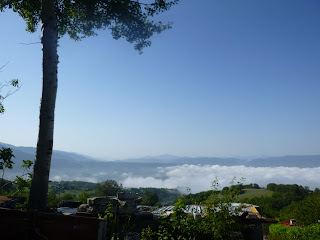












































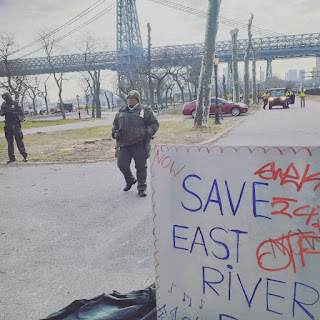









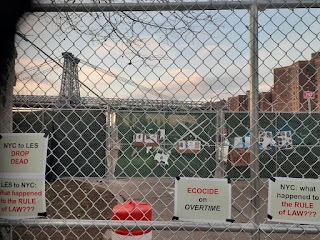
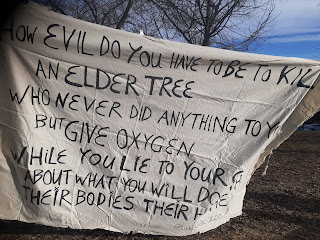


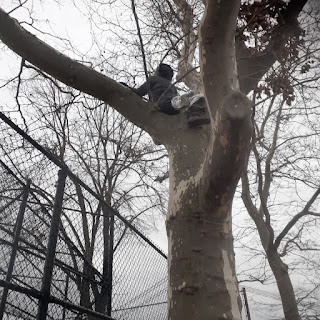

















No comments:
Post a Comment